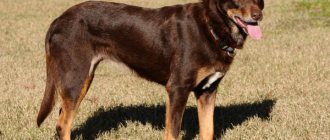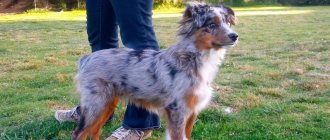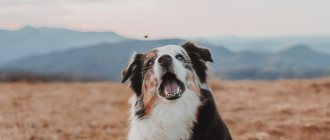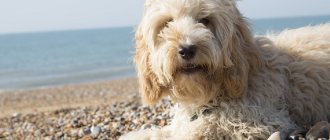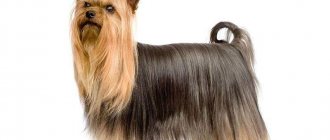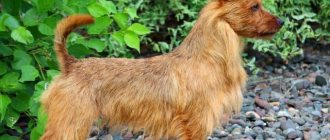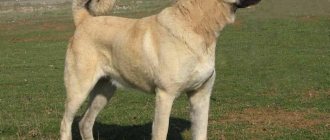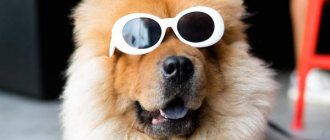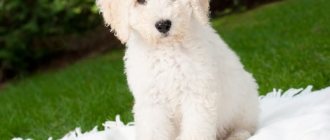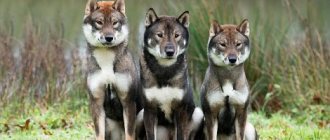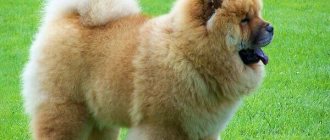There are several dozen dog breeds around the world, and even more if you count those that are not officially recognized by canine federations. Due to such breed diversity, some representatives of the canine world remain in the shadows and are considered little-known. Today we will talk about Australian Kelpies - just such a rare breed.
The Australian Kelpie is an energetic shepherd dog. These small animals are very popular and famous in their homeland, but are extremely rare outside the Australian continent. Today we will talk about the history of Australian shepherd dogs, their characteristics, nuances of keeping and character.
Australian Kelpie
Breed characteristics
Height at withers for males: 46-51 cm Height at withers for females: 43-48 cm Weight: 11-20 kg
Color:
- black;
- ginger;
- pale yellow;
- chocolate;
- blue;
- there may be scorch marks.
Additional standards:
- The body of the Australian is covered with straight, close-lying guard hair, under which a thick undercoat is hidden. On the hind limbs the hair forms “pants”.
- The head resembles a fox, proportional, with clean, even lines, smooth lips. The ears are erect and pointed. The neck is without dewlap, smooth, strong.
- The tail is straight and lowered when calm.
- The eyes are almond-shaped, brown, in harmony with the color of the coat.
- The color of the nose also matches the color of the dog.
How to care?
The Kelpie breed was bred by Australian farmers in the outback, so even at that time the dogs were accustomed to simple conditions of care or did without it at all. Based on this, modern representatives of the breed are absolutely unpretentious in their maintenance. All your pet needs is periodic brushing of its fur. It is not necessary to bathe dogs, as they perform water procedures on their own. Every evening the owner needs to check the dog for injuries and damage.
Representatives of this breed are vaccinated against the following diseases: parvovirus enteritis, distemper, infectious hepatitis, rabies, trichophytosis and coronavirus. The first vaccination should be given to babies at the age of two months; after vaccination, the pet should not be taken outside, washed or overfed for the first 12 days. It is forbidden to give vaccinations when a young dog's teeth are changing. A one-year-old dog is given a comprehensive vaccination, information about which must be entered in the pet’s passport.
Australian Shepherd bitches require special care during heat, which first occurs between the ages of 8 and 12 months and repeats at regular intervals every 6 months. Estrus usually lasts no more than 22 days, in some cases it can drag on for a month. The appearance of bloody discharge and swelling of the external genital organs indicates that estrus has begun. During this period, dogs urinate more frequently, so the owner will have to walk the pet more. In addition, the pet’s behavior changes; it can be lethargic or, conversely, aggressive; the dog eats less and drinks more water.
In the case when the owner of a kelpie is interested in obtaining offspring from a dog, then during estrus he must take certain precautions
- It is necessary to go for walks with a bitch only on a leash, since even the most obedient individual at this time can turn into an uncontrollable animal and run away at any moment. Also, during estrus, bitches stop responding to the owner’s commands, so they should not be allowed near male dogs. Accidentally started sexual intercourse on the street cannot be stopped and, as a result, it threatens an unwanted pregnancy or the fact that non-purebred babies will appear in the house.
- In autumn and winter, during estrus, the dog can quickly get cold, so it is recommended to reduce walks to a minimum. Additionally, special dog clothing will help protect your dog from hypothermia. If the pet lives freely on a personal plot, it is recommended to cover it in an enclosure.
History of the breed
Kelpies were bred by Australian shepherds by mixing the blood of the wild dog dingo and the smartest of all dog breeds - the border collie. There is also an opinion that they descended from dogs that arrived in Australia along with the first settlers. The first mention of the breed dates back to the end of the 19th century.
The fact that the breed originated from dingoes is supported by the fact that some habits of wild dogs can be traced. When the kelpie works in the field and herds cattle, she lowers her head so low as if she is about to attack a sheep. This behavior is more reminiscent of hunting than herding, but it is a distinctive feature.
This breed of dog got its name from the spirit of the stormy river Kelpie - the Water Horse, which is mentioned in the novel “Kidnapped” by the Scottish writer Robert Louis Stevenson.
Professional breeding of these herding dogs in Australia began only in 1956; now more than 100 thousand Kelpie dogs live on the southern continent.
Dogs came to Russia in the 80s of the 20th century. In 1987, the USSR purchased 30 kelpie puppies from Australia for use on sheep pastures on state farms in the Stavropol Territory and other regions of the country.
Nowadays, the Kelpie is the most popular and beloved herding dog in Australia and other countries of the world, although these dogs are little known in Europe.
The Australian Kelpie also managed to appear in cinema: the film by Kriv Stenders “Red Dog” tells the story of a dog of this breed.
Coolie
The Coolie is a working or herding dog that has existed in Australia since the early 19th century, where it was introduced from Britain. The name of the breed probably comes from "collie", and its appearance resembles a border collie.
Basically, coolies are known as excellent shepherds with developed instincts for “circling” around livestock (mainly sheep) and returning strays to their herd.
These dogs are characterized by a calm disposition, patience, loyalty to their owner, and also agility. They are indispensable on the farm during the birth of lambs, as well as during the wool collection.
Breed overview
- group: not recognized by canine organizations
- height: 40.6-61 cm
- weight: 15-24 kg
- coat: short, medium length, in rare cases long.
- color: red or blue merle, chocolate, black, two-tone.
- life expectancy: up to 18 years
Behavior and temperament
Kelpie knows how to smile. He is friendly, affectionate, but at the same time a vigilant guard of his owner and property.
The Australian Kelpie is eager to work and happily carries out instructions from its owner. This breed of dog can easily cope with numerous flocks, flocks of poultry, and herds of cattle.
While working, the kelpie skillfully makes the animals obey her, and in order to easily run from one end of the herd to the other, the dog instead of the ground moves along the backs of the animals entrusted to it.
Character advantages:
- smart;
- curious;
- hardy;
- independent;
- attentive;
- loyal.
There are also disadvantages:
- selects only one owner;
- hyperactivity in the absence of training and activities.
Application
Australian Shepherds are natural herders. They are used for grazing sheep both in pens and in open areas. Dogs are able to work without human supervision in a group or alone.
Kelpies now sometimes serve in police or search and rescue units. If desired, you can develop a guard instinct in them.
Australian Kelpie and man
Kelpie is a shepherd, guard and even hunter. He swims well, runs briskly, even climbs trees, and is able to remain for a long time without food and water while working in the pasture. This is a universal dog, and for him work is happiness . For Kelpies, the more work the better.
He equates lying on the couch with death. Therefore, the Kelpie is not the best option for a pet in an apartment ; he feels bad in it and, out of boredom, destroys everything from slippers to opening the linoleum. A dog can live in the city, but only under the condition of high physical and mental stress.
The ideal habitat for such a dog is a country house, a farm , and always with a lot of work - guarding livestock, herding, learning new tricks, and constant training.
The Australian Kelpie is good-natured and gets along with children , does not offend children, and gets along with other pets. Due to its “specialization,” the kelpie begins to herd small children and other animals.
Character
Thousands of Australian and American cattlemen will say that these dogs are a vital part of their work. Although show kelpies are slightly less energetic than their working brothers, this difference is only noticeable to the farmer.
They are loyal and form relationships with their owners that last a lifetime. Some of them love only the owner, while others love all family members.
Although they prefer the company of their owner, they can work for hours without his help or orders, alone or in a pack with other dogs. Their attitude towards strangers depends on socialization.
When correct, they are friendly and polite; when incorrect, they are wary or slightly aggressive. They are always alert and can be good guard dogs, but they are not ideal as they are small and not very aggressive.
Australian Kelpies are tireless working dogs. They were bred as herding dogs and have all the characteristics necessary for such a breed.
After a hard day at work, Kelpies come home to relax and therefore get along well with children. But for little ones they are not ideal companions, as they play too harshly and can pinch the child.
They are used to pinching and biting sheep to control them. And with little ones they can behave like sheep in order to control them. Although this is instinctive behavior, not aggression, and the dog can be weaned from it.
In relation to other animals, they behave differently. Because they often have to work in a pack, they can form strong bonds with other dogs. They have low aggression towards strangers. But, most males try to take a dominant position, although they are not as dominant as other breeds.
Australian Kelpies work with livestock, and can live with almost all animals in the world. However, it is in their blood to drive any animal, be it a bull or a cat, which can lead to injury in small pets. Not very often, but in untrained kelpies this instinct can develop into a hunting instinct.
This is an intelligent and easy to train breed.
There is nothing that they cannot learn, and very quickly. Although they are used as herding dogs, they also serve as rescue dogs and working dogs. However, for an inexperienced owner, the training will be a real test.
Kelpies are independent and like to do what they want. They don't need to give commands, they know everything that way. Without being dominant, they quickly understand who needs to be listened to and who can be forgotten.
If you fall into the second category, then you have problems, as they love to play mischief. If you don't put them in place, they bloom.
Like the Australian Cattle Dog, Australian Kelpies require a huge amount of activity and work. They are born to work for a long time under the scorching sun, until the moment they literally collapse from fatigue. They have become an important part of the Australian livestock industry and not only do they have to work, they can't sit idle.
Not only a daily walk, but even a jog is not enough for them; they need several hours of heavy exercise every day; free space for running and keeping a kelpie in an apartment will be akin to a disaster. For an ordinary city dweller, the requirements are impossible to meet, since the dog needs a lot of exercise. And if you are not able to give it, then it is better to refuse to buy a kelpie.
Even the most educated and self-possessed of them become terrible if they do not receive their due. They can destroy everything in the room, if not in the apartment, howl, bark, and chew. And then they develop manic states and depression.
In order for the Kelpie to be happy, the owner must load it not only physically, but intellectually. And it doesn’t matter whether it’s sheep management or an agility course. Unlike other breeds, Kelpies' energy levels do not decrease with age. Most dogs are just as active at 10-12 years old as they were at 6-7.
Naturally, they are best suited for farmers, especially those involved in livestock farming. A lot of work, a big yard and freedom, this is the recipe for their happiness.
Maintenance and care
Since the Australian Kelpie prefers to move a lot, such a dog should not be locked in a small enclosure or apartment. If you are not a farmer, but are going to become the owner of such a dog, then immediately take care of long walks with games and running , as well as training with the dog.
It tolerates heat and cold , but at critically low temperatures it is worth taking care to keep the animal warm.
Grooming is minimal - the dog is brushed once a week. During shedding, use a slicker brush.
When feeding, the amount and calorie content of food is calculated taking into account the dog’s employment, living conditions, and time of year. Keep in mind that two dogs of this breed have different metabolisms, so nutrition is selected individually.
Nutrition
The nutrition of puppies and adults should vary depending on their physiological state, physical activity, type of activity, time of year, and age. Therefore, let us consider in more detail the features of feeding animals of different ages.
Puppy
Dog handlers advise sticking to feeding your puppy four times a day. But you shouldn't feed your pet. If he doesn't finish the whole portion, don't force him. Also, do not give him sweet or salty foods. Prepared food must be cooled so that it is not hot; But food that you just took out of the refrigerator should not be given to the animal right away either.
If you got a puppy, it will be useful for you to read about how to feed a puppy, at what age to give a puppy the first vaccination, what are the basic rules for training a puppy at home, how to teach him the commands “Come to me” and “Give me a paw”, and also, what are they for and how to motivate your dog with treats.
Important! Under no circumstances feed puppies sweet, spicy, or salty foods. Avoid food with spices
Do not feed tubular bones, pork, whole milk, river fish, legumes, cabbage, potatoes, or sausages.
Adult
Food for an adult dog per day is calculated as 5% of the total weight of the animal. Basically, chicken, beef, porridge, cottage cheese, eggs should predominate. Feed your kelpies beets, carrots, cucumbers, zucchini, pumpkin, and greens.
For better digestion of food, give stewed vegetables. The dog is not fed broths and soups, because then its belly sags.
Education and training
The Australian Kelpie is a quick-witted, intelligent, attentive friend and is highly trainable . He is not lazy if he perceives training as part of the job. Training with such a dog is a pleasure, because the Kelpie picks up everything on the fly.
Does not accept oppressive training methods; it is better to use positive reinforcement - treats, games. The puppy should be socialized as early as possible.
In urban conditions, engage your dog in an active type of dog sport - Frisbee, agility, bikejoring, skipulling, freestyle dog, and so on. The main thing is that training and exercises are regular.
Mating
Mating must be taken very seriously in order to get healthy offspring:
- Before the procedure, be examined by a veterinarian and take genetic tests. Unfortunately, if the dog is a carrier and especially a carrier of a disease that will affect the offspring, mating is prohibited. Various crossing options are considered when there is a high probability of the birth of healthy puppies. The breeders are responsible in each case.
- Heelers that have reached 1.5 years of age are considered sexually mature. Bitches go into heat in the autumn and spring. It is customary for owners to breed a pair on the 2nd or 3rd heat and 8–10 days after the start.
- Mating takes place traditionally in the territory of the male. If the male does not recognize the female and shows aggression, the procedure is repeated every other day. The best time of day for mating is morning.
- After proper mating and three months of gestation, puppies appear. The quantitative component of the litter is 1 – 7 pieces.
Breed photo
A selection of photos of the Australian Kelpie.
Add a comment Cancel reply
Health
The harsh living conditions endowed the kelpie with good health. However, it is better not to refuse regular visits to the veterinarian. These dogs have a high pain threshold. They remain cheerful and cheerful even when they feel unwell. A specialist will be able to detect the beginnings of the disease in time.
Diseases
Some Australian Kelpies suffer from:
- joint dysplasia;
- cryptorchidism;
- deafness;
- retinal atrophy.
To identify diseases, genetic analysis is performed. Dogs suffering from these ailments are not allowed to be bred.
Vaccinations
Puppies are vaccinated at two and three months of age. First they give the PUPPY series vaccine, and a little later they vaccinate against:
- hepatitis A;
- plague;
- parainfluenza;
- enteritis;
- leptospirosis;
- rabies.
At the sixth month of life, repeated vaccination is carried out. Adult dogs are vaccinated every year and regularly treated against fleas and ticks.
Aussie
This is a fairly popular breed, which, contrary to its name, was factory bred in the USA. It has the following characteristics:
- Country of origin: USA.
- The maximum height at the withers is fifty-eight centimeters.
- The permissible weight ranges from seventeen to twenty-five kilograms.
- A distinctive feature is the marbled color, but red, brown and spotted are allowed. The coat is long and thick. Lifespan is about thirteen years.
- The year of registration is 2005.
Literature
- Pavlova M.V., Novopashina S.I.
Determination of the degree of expression of the herding instinct in kelpie puppies. Guidelines. - Stavropol: SNIIZHK, 2006. - 20 p., ill. - Pavlova M.V., Novopashina S.I., Sannikov M.Yu.
Training of Australian Kelpie dogs when working with various types of farm animals. Guidelines. - Stavropol: SNIIZhK, 2009. - 31 p., 14 ill. - Austin T.
Our Australian Kelpie. - High Thunder Publishing, 1989. - 128 pp., - ISBN 0-646-01053-0 (English) - Parsons T.
The Kelpie. The Definitive Guide to the Australian Working Dog. — Penguin Books Australia, 2010. — 720 p. — ISBN 978-0-670-07359-7 (English)
Selection rules
You should only buy a puppy from a registered nursery. In this case, a person receives a purebred puppy from trusted parents. It's not always easy to choose a baby from a litter. You need to observe all the puppies and take a closer look at their behavior.
It is advisable to choose a child who is active and interested in everything, who plays with others, shows curiosity and interest in new objects.
approximate cost
The Australian Kelpie is a rare breed. Therefore, the price of a puppy will be high - about forty thousand. A puppy with minor exterior defects can be bought for thirty thousand rubles*.
The only nursery “Geares” operates in Moscow. If you wish, you can contact other countries, but then the cost of the baby will be higher.
